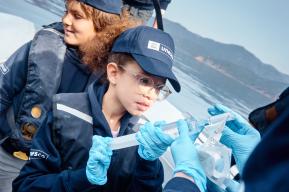观点
海底的两万种声音

很久以来,我们一直认为海洋是一个寂静无声的世界。事实恰恰相反,声音对于众多海洋生物具有重要作用,而人类活动产生的噪声正威胁着某些物种的存续。巴塞罗那加泰罗尼亚理工大学应用生物声学实验室(LAB)主任、声学家米歇尔·安德烈(Michel André)向我们警示了这种噪声污染带来的种种危害。
蕾蒂西亚·凯西(Laetitia Kaci,联合国教科文组织) 担任采访
海底有声音吗?
在海洋中,声音是生命的同义词。由于光只能射入水下数米,无法穿透深水,声音就是海洋居民用来交流信息的唯一媒介。
直到近20年左右,我们才充分认识到这些声音的重要性。事实上,由于构造问题,人耳听不到水下的声音,海底的声音一直以来都被忽略了,雅克-伊夫·库斯托(Jacques-Yves Cousteau)和路易·马勒(Louis Malle)在1956年拍摄的纪录片《寂静的世界》就反映了这一点。
由于开发出了水听器等能够捕捉水下声音的新设备,我们现在可以证实海洋里有两万种声音。这些声音对于海洋生物至关重要。
这一发现还让我们认识到人类活动所产生的噪声之大。自80多年前人类对海洋资源进行工业化开发以来,我们一直在不知不觉中对海洋造成声学污染。
80多年来,我们一直在不知不觉中对海洋造成声学污染
这项发现带来了哪些后果?
当人们意识到人为噪声可能威胁到海洋的平衡时,科学界首先将注意力放在了鲸目动物的89个物种上。迄今为止,我们已经成功确定了其中近25%的物种对于声音的敏感程度。这些物种日常通过声音交流,从而进行狩猎或繁殖,它们的大脑通过感知声音完成了进化,其中部分物种已经存在了3000多万年。
10年前,我们发现海洋无脊椎动物(头足类、甲壳类、贝类、水母、珊瑚等)生有感觉器官,可以在水中平衡重力。这些物种没有听觉系统,但是可以敏锐地感觉到声振。如果处在人为噪声环境当中,它们会遭受可能致命的声创伤。这是海洋平衡所面临的最严重威胁之一。
人为噪声威胁到海洋的平衡
这种噪声会对海洋动物产生哪些影响?
主要影响是干扰交流信号。由于噪声污染,海洋动物无法获得生存所需的声音信息。例如,噪声会使鲸目动物迷失方向,还会导致它们听不到船只靠近的声音。
噪声还可能成为致命武器。在有些情况下,这些声音对于动物的感觉器官来说过于强烈,会造成直接创伤,使某些生物面临性命之忧。与石油勘探或水下军事演习有关的声源就属于这类噪声。
最后一点,就是声创伤的影响。长期接触声源,海洋动物的某个感觉器官会产生疲劳,形成不可逆的损伤,例如再也无法接收声音。
2020年春季,全球各地实施封锁,运输量因此下降,这是否会减轻海洋中的噪声污染?
2020年,我们通过全球水下观测网络“倾听深海环境”(LIDO),对不同噪声级进行了比较研究。封锁确实减少了海上运输活动,噪声强度也因此减弱,但降幅并不大,与一年当中运输量通常相对平缓的其他时段大致相当。
如何消除这种噪声污染?
早在10多年前,从业者就已经掌握了有助于减轻声波冲击的技术。以现代运输船为例,轮机舱现在都是隔音的,以防止噪声和振动通过船体传入水中。
一些行业正在主动采取措施,减少与自身活动相关的噪声。例如,风力发电场的建造者正在研究薄膜和气幕装置,以削减风力涡轮机产生的噪声。
最后要说明的是,我们现在已经可以对石油勘探或军事行动的相关声源采取行动了。利用现代技术,我们能够检测到可能受噪声影响的物种,并先让这些物种远离作业区,以降低风险。
本次采访属于联合国教科文组织《信使》与“即刻改变”组织的一项合作。该组织的2021年峰会将于5月27—29日在巴黎召开,届时,决策者、企业家和创新者将齐聚一堂,为可持续发展的世界贡献具体解决方案。
拓展阅读:
《从水肺到深潜器》,作者雅克-伊夫·库斯托,联合国教科文组织《信使》,1960年7-8月。
《雅克·伊夫·库斯托访谈录》,联合国教科文组织《信使》,1991年11月。
订阅联合国教科文组织《信使》,阅读发人深省的时事文章,数字版免费。
在社交网络上关注联合国教科文组织《信使》:微博、微信公众号“联合国教科文信使”、Twitter、Facebook、Instagram。
Interview by Laetitia Kaci
UNESCO
Does the ocean produce noise?
In the ocean, sound is synonymous with life. Since light does not penetrate more than a few metres below the surface, it is the only medium of information the inhabitants of the sea have at their disposal to communicate.
But it is only in the last twenty years or so that we’ve fully realized the importance of these sounds. In fact, since the human ear is not designed to hear underwater, the sounds under the sea have long been ignored – as shown in The Silent World, the 1956 documentary directed by Jacques-Yves Cousteau and Louis Malle.
Today, thanks to the development of new devices, such as hydrophones, that are capable of capturing underwater sounds, we can now confirm that the sea is a world of 20,000 sounds. These are essential to marine life.
This discovery has also opened our eyes to the intensity of noise produced by human activities. For over eighty years, since the beginning of the industrial exploitation of marine resources by humans, we have unknowingly been polluting the ocean acoustically.
For over eighty years, we have unknowingly been polluting the ocean acoustically
What are the consequences of this discovery?
As soon as it became clear that noise from anthropogenic sources could threaten the equilibrium of the ocean, the scientific community first turned its attention to the eighty-nine species that make up the order of cetaceans. Today, we have managed to determine the acoustic sensitivity of nearly twenty-five per cent of these species that use acoustic exchange on a daily basis, either for hunting or reproduction. The evolution of their brains is based on this perception – for more than 30 million years, in the case of some species.
Ten years ago, we discovered that marine invertebrates (cephalopods, crustaceans, shellfish, jellyfish, corals, etc.) have sensory organs to manage gravity in the sea – even though they have no auditory system. These species are sensitive to the perception of sound vibrations. Exposed to anthropogenic noise, they suffer acoustic trauma that threatens their survival. This is one of the most serious threats to the ocean’s equilibrium.
Anthropogenic noise threatens the equilibrium of the ocean
What is the impact of this noise on marine fauna?
The primary effect is to interfere with communication signals. The sound information necessary for survival does not reach the species because of this noise pollution. For instance, noise can disorient cetaceans and prevent them from hearing a boat approaching.
Noise can also be lethal. The sound source produced is sometimes so intense for an animal receptor that it causes immediate trauma that can be fatal for certain organisms. This is the case for sound sources associated with oil exploration or military underwater manoeuvres.
Finally, there is acoustic trauma. Long-term exposure to a sound source can cause fatigue of one of the species’ receptor organs, leading to irreversible damage – such as the inability to pick up sounds.
Did the drop in traffic caused by the global lockdown in spring 2020 lead to a decrease in noise pollution in the ocean?
Our global underwater observatory network, Listening to the Deep Ocean Environment (LIDO), enabled us to carry out a comparative study of different noise levels in 2020. The lockdown did indeed lead to a reduction in the traffic of activities at sea, and thus there was a decrease in the intensity of the noise level. But this decrease was not significant. It was comparable to other periods of the year when traffic is usually less dense.
How can we fight this noise pollution?
For more than ten years, the technology has been available to operators to help their efforts to reduce acoustic impact. In modern transport ships, for example, the engine room is now insulated to prevent noise and vibrations from passing through the hull and into the water.
Some industries are taking initiatives to reduce the noise associated with their activities. Wind farm builders, for example, are working on membrane and bubble curtain systems to reduce the noise created by the installation of wind turbines.
Finally, it is now possible to act on the sound sources linked to oil exploration or military operations. Today’s technologies make it possible to detect the presence of species that could suffer from the impact of noise and to wait until they move away from the areas of operation, in order to limit the risk.
This interview marks The UNESCO Courier's collaboration with ChangeNOW. Its 2021 summit, to be held in Paris from 27 to 29 May, brings together decision-makers, entrepreneurs and innovators, to propose concrete solutions for a sustainable world.







